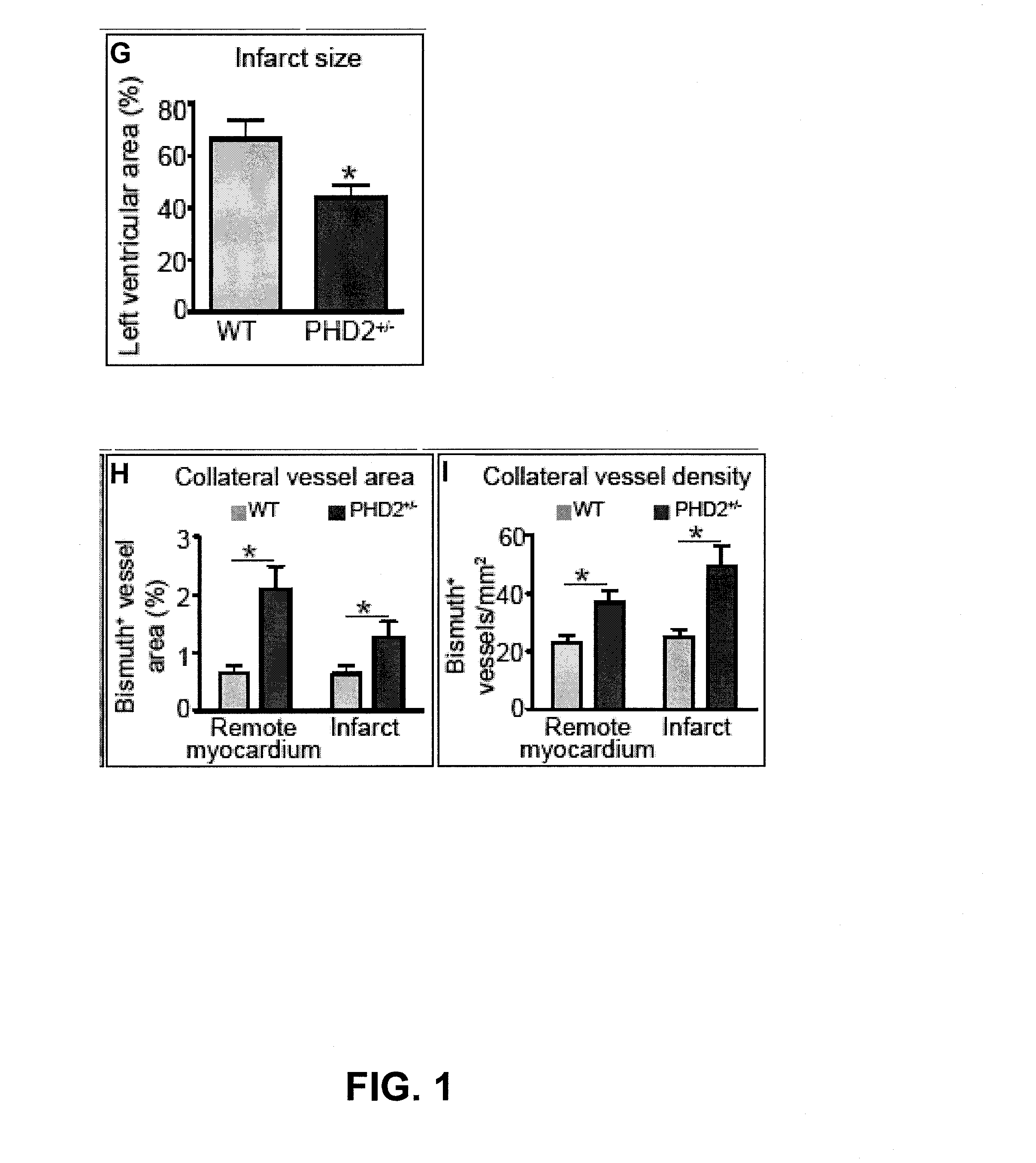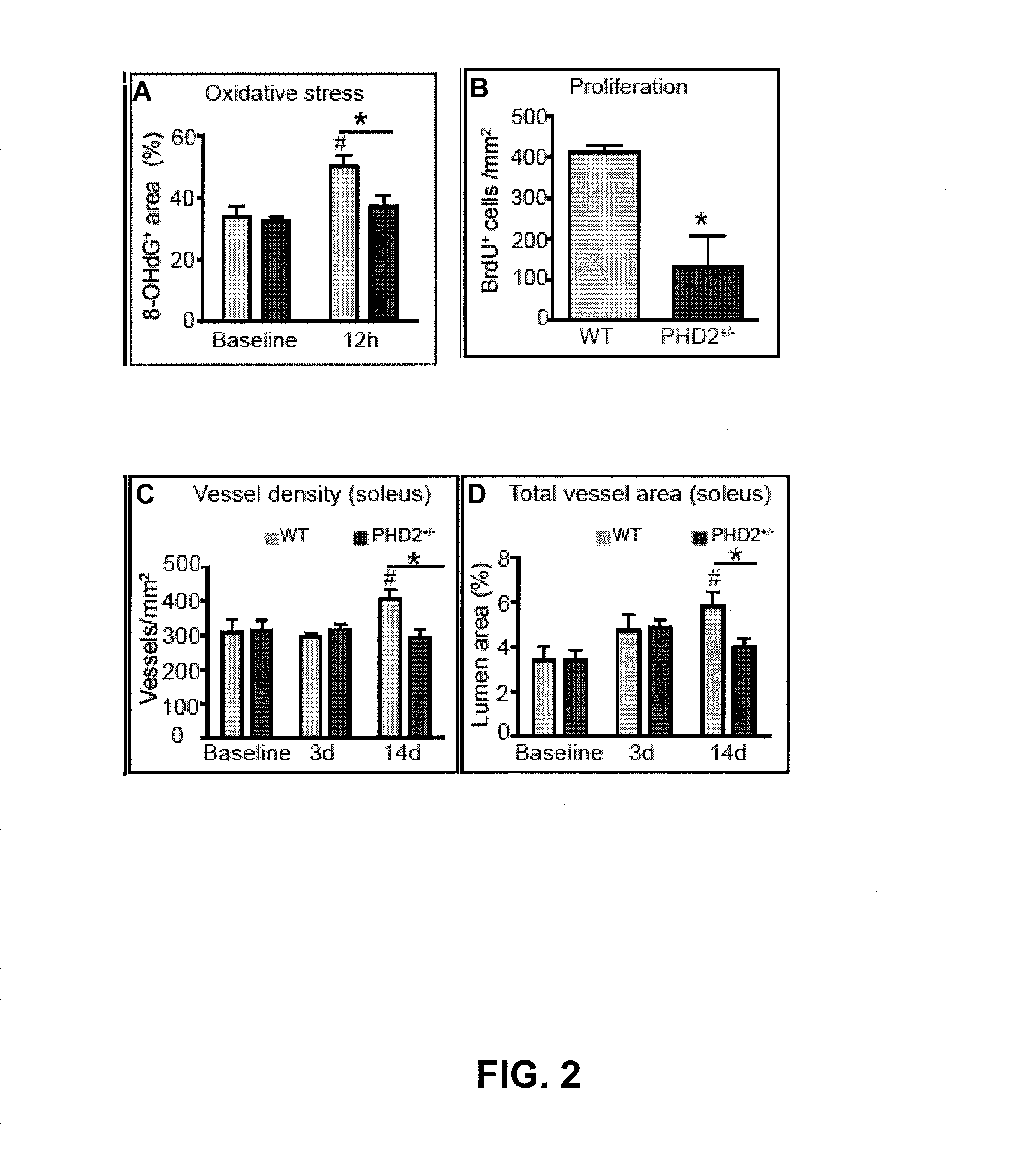Induction/monitoring of arteriogenesis using sdf1 and pdgfb or inhibition of phd2
a technology of arteriogenesis and sdf1, which is applied in the field of ischemia, can solve the problems of tissue dysfunction and demise, hypoxia and infarction of dependent vascular territories, and subsequent hypoxia of dependent vascular territories, and achieves the effects of enhancing collateral perfusion, increasing the arteriogenic gene expression, and increasing the arteriogenic profile of these myeloid cells
- Summary
- Abstract
- Description
- Claims
- Application Information
AI Technical Summary
Benefits of technology
Problems solved by technology
Method used
Image
Examples
example 1
Generation of PHD2+ / − Mice and Expression of PHD2
[0104]This was done as described before (PCT / EP2010 / 050645; Mazzone et al., 2009). In brief, to study its biological role in vivo, we inactivated the PHD2 gene in the germline. PHD2-deficient (PHD2− / −) mice died at mid-gestation, while PHD2+ / − mice developed normally, were healthy, and did not exhibit vascular defects; physiological angiogenesis was also normal. PHD2 mRNA and protein were undetectable in PHD2− / − embryos and present at 50% of the normal levels in healthy organs in PHD2+ / − mice, with minimal up-regulation of PHD3. Also, cultured PHD2+ / − cells expressed 50% of the normal PHD2 levels at various oxygen tensions. Consistent with previous findings that PHDs are HIF-targets and up-regulated in chronic hypoxia (Appelhoff et al., J. Biol. Chem. 279:38458-38465, 2004; Epstein et al., Cell 107:43-54, 2001; Marxsen et al., The Biochemical Journal 381:761-767, 2004, Aragones et al., Nat. Genet. 40:170-180, 2008), PHD3, and to a les...
example 2
Targeting PHD2 in Ischemic Diseases
[0105]Apart from its usefulness in disorders characterized by excessive angiogenesis, such as cancer and AMD, experiments have demonstrated that PHD2 inhibition may be useful in the treatment of ischemia, i.e., in conditions where a restriction in blood supply exists (PCT / EP2010 / 050645). Although at first sight this may appear contradictory, the examples shown therein demonstrate that heterozygous deficiency of PHD2 results in mature and more stable pathological vessels, which is beneficial in ischemic conditions. For instance, this was evaluated in a limb ischemia model after femoral artery ligation in WT and PHD2+ / − mice. To induce limb ischemia, the right femoral artery was occluded distal to the branch site of the deep femoral and the popliteal artery. After 1 or 3 or 14 days, mice were perfused with fixative and bismuth-gelatin contrast medium for angiography. Collaterals in the adductor muscle were used for morphometry.
PHD2 Haplodeficiency Pr...
PUM
| Property | Measurement | Unit |
|---|---|---|
| diameter | aaaaa | aaaaa |
| diameter | aaaaa | aaaaa |
| diameter | aaaaa | aaaaa |
Abstract
Description
Claims
Application Information
 Login to View More
Login to View More - R&D
- Intellectual Property
- Life Sciences
- Materials
- Tech Scout
- Unparalleled Data Quality
- Higher Quality Content
- 60% Fewer Hallucinations
Browse by: Latest US Patents, China's latest patents, Technical Efficacy Thesaurus, Application Domain, Technology Topic, Popular Technical Reports.
© 2025 PatSnap. All rights reserved.Legal|Privacy policy|Modern Slavery Act Transparency Statement|Sitemap|About US| Contact US: help@patsnap.com



